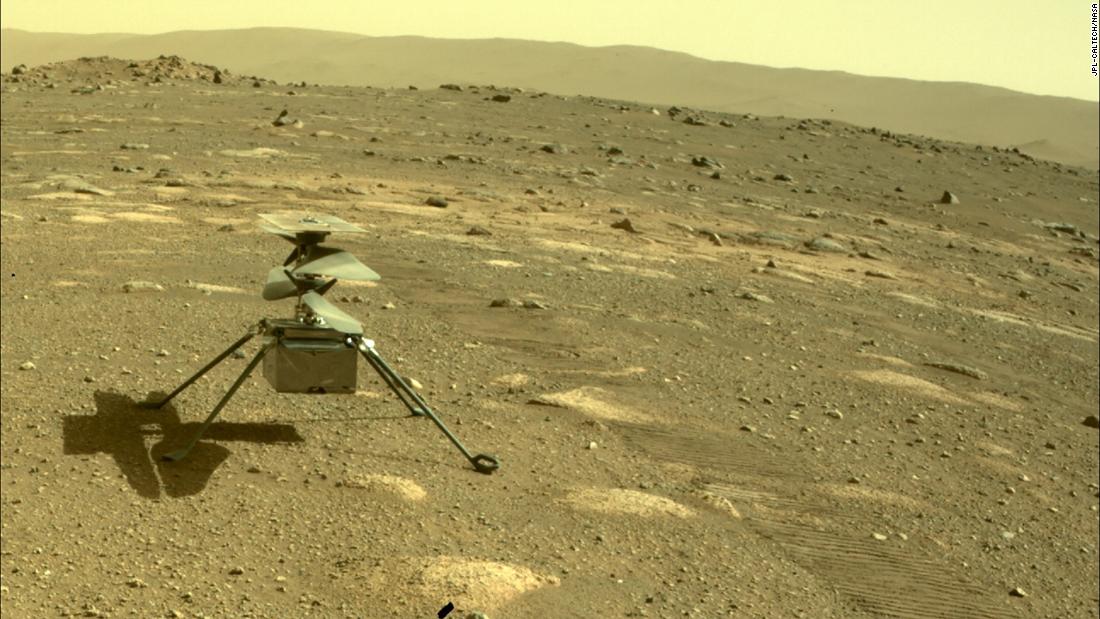(CNN) – The ingenious helicopter survived its first night on the icy surface of Mars, an important milestone in the plane’s journey before its historic maiden flight.
The current base of Mars’ former lake bed and the ground floor of the Perseverance rover and the temperature of the Xerox crater in the invention helicopter could drop to -90 degrees Celsius. This is low enough to cause significant damage to the helicopter’s battery and electrical components.
The 2kg helicopter finally detached from the Perseverance Rover’s stomach on April 3, before it was launched from Earth in July.
Before dropping the last 10 centimeters on the surface of Mars, the ingenuity continued to deploy from the bottom of the rover, which looked like the transformation of a butterfly.
Low, pleasant helicopterASNASAPersevere Uses slowly and carefully # Mars Helicopter, Ingenuity. The technology demo is now out of its storage state and ready to safely touch the surface of Mars. See upcoming milestones: https://t.co/TNCdXWcKWE pic.twitter.com/3AyaiHOH2k
– NASA JBL (ASNASAJPL) March 30, 2021
“This is the first time there has been intelligence on the surface of Mars,” Mimi Ang, NASA’s project manager at NASA’s Jet Propulsion Laboratory in Pasadena, California.
“But now that we’re sure we have the right insulation, the right heaters and enough battery power to sustain a cold night, this is a huge success for the team. We are pleased to continue to produce ingenuity for its first flight test.”
LEE: Ingenious helicopter explores Mars: This is a historic journey to fly to another planet
The next record was the plane
This is the first controlled flight to operate on another planet, while the ingenious flight that could occur before April 11th. For the first such record on earth, the ingenious Wright brothers carry a cloth swatch from Flyer 1, an aircraft.
The ingenuity of the first helicopter sent to Mars presented a challenge to the engineers who designed it for a number of reasons.
It must be small enough to fit under the rover without compromising the diligent task of searching for evidence of ancient microbial life on Mars.
The ingenuity to fly through the Martian atmosphere must be light, which contains only 1% of the Earth’s atmosphere. This is when Tuesday nights are hot and have enough energy to survive. The thinness of Mars’ atmosphere makes it very difficult to create lifts and lifts.
The rover took off from the helicopter shortly after the diligence was deposited in the center of its airport. This allowed the solar team of the helicopter to collect vital sunlight.
Diligence sent pictures of the four legs of the helicopter to the surface on April 4th. Helicopter blades currently stacked on top of each other will be stopped on April 7th. The mission team on Earth will send commands to the helicopter to “walk” the plates.
The helicopter will have to go through some tests on its computers, which will allow it to fly intelligently automatically through the Martian atmosphere.
Now that the ingenious rover has not borrowed power and heat, the helicopter will send information about the performance of its power and thermal control systems for the next two days. This will allow the helicopter team to configure the necessary settings to ensure that the ingenuity survives the next 30 days of its organization.
Technology Demonstration
Ingenuity is a technical demonstration, which means that its scope is narrower compared to the rover’s two – year plan to explore the Jesuit Valley. Now that the helicopter is on the surface of Mars, there are 31 Earth days or 30 Mars to make up to five test flights.
During the first flight, the helicopter tries to soar in the air about 3 meters from the center of its flat 10-by-10-meter airport, then turns and touches the bottom again. The test should take about 30 seconds. Future aircraft will test the helicopter’s high and long flying capability.
Meanwhile, the diligent rover sits in a nearby search and watches the plane, capturing images, video and audio. These will arrive on Earth within a few days of the first flight.
LEE: NASA shares the first video and new images of Mars’ perseverance
Once the ingenious voyage is over, the rover will focus on its scientific work and begin to study the rocks and collect samples that will return to Earth in future projects.
“Our 30-solar test program is progressing with amazing milestones,” said Teddy Janetos, deputy director of the Jupiter Intelligence Helicopter on Mars. “Whatever the future holds, we will get as much aviation data as we can within that time frame.”





:quality(85)//cloudfront-us-east-1.images.arcpublishing.com/infobae/GUWKQHQBHJGBHA5BXUFNQEEBVE.jpg)